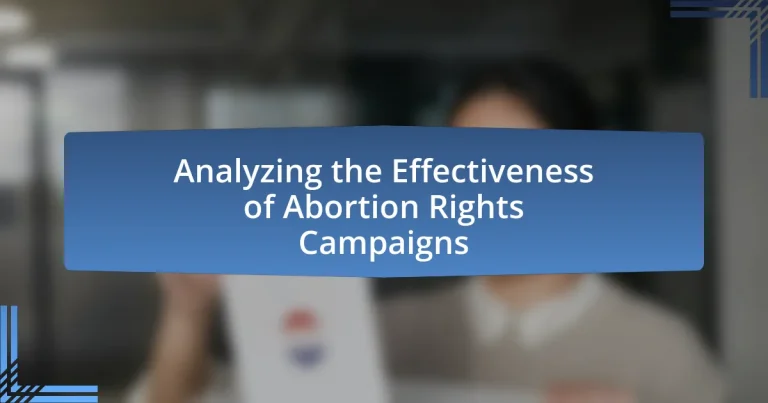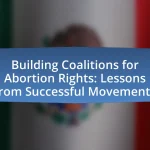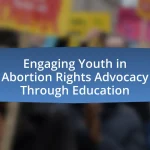Abortion rights campaigns are organized efforts advocating for the legal right to access abortion services, aiming to influence public policy and raise awareness about reproductive rights. These campaigns operate through advocacy, education, and grassroots mobilization, utilizing strategies such as coalition building and targeted messaging to engage communities and shape societal attitudes. Key stakeholders include women’s rights organizations, healthcare providers, and policymakers, all working together to promote women’s autonomy and ensure access to safe abortion services. The effectiveness of these campaigns can be measured through changes in public opinion, legislative outcomes, and access to abortion services, highlighting their significant impact on reproductive health and rights.
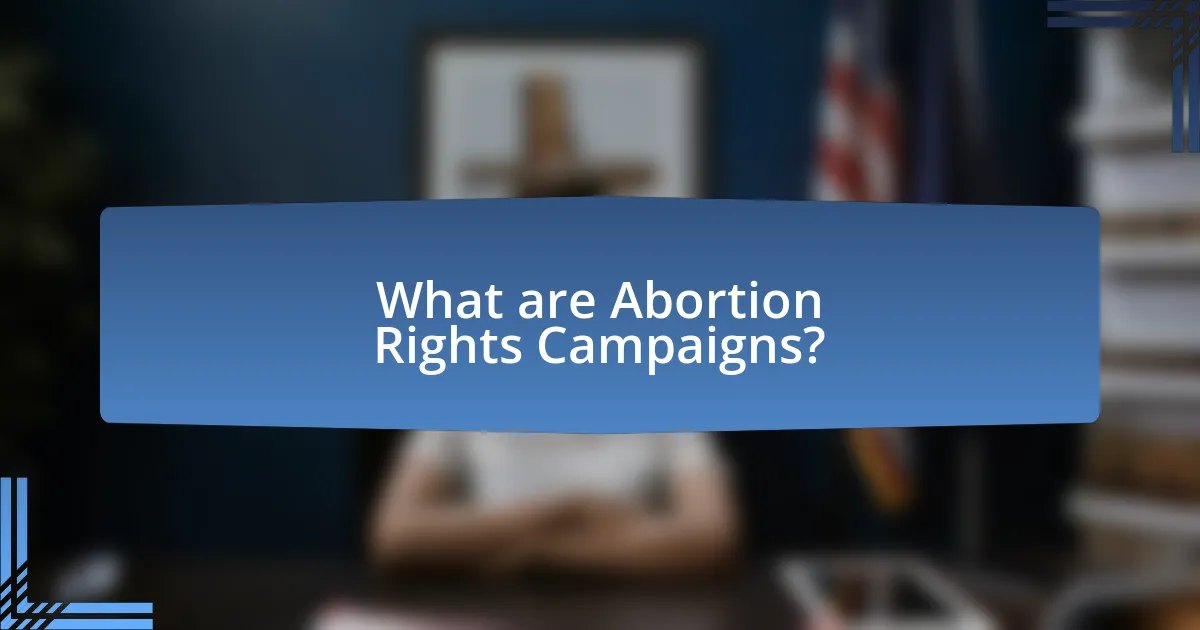
What are Abortion Rights Campaigns?
Abortion rights campaigns are organized efforts advocating for the legal right to access abortion services. These campaigns aim to influence public policy, raise awareness about reproductive rights, and mobilize support for legislation that protects and expands access to abortion. For instance, in the United States, organizations like Planned Parenthood and the National Abortion Federation have been pivotal in promoting abortion rights through educational initiatives and legal challenges against restrictive laws. The effectiveness of these campaigns can be measured by changes in legislation, public opinion, and access to abortion services, as seen in various states where advocacy has led to the repeal of restrictive abortion laws.
How do Abortion Rights Campaigns operate?
Abortion rights campaigns operate through a combination of advocacy, education, and mobilization efforts aimed at protecting and expanding access to abortion services. These campaigns often utilize grassroots organizing to engage communities, raise awareness about reproductive rights, and influence public policy. For instance, organizations like Planned Parenthood and the National Abortion Federation conduct outreach programs that inform individuals about their rights and available services, while also lobbying for legislative changes that support abortion access. Additionally, data from the Guttmacher Institute indicates that states with active abortion rights campaigns tend to have more protective laws regarding reproductive health, demonstrating the effectiveness of these campaigns in shaping policy outcomes.
What strategies are commonly used in these campaigns?
Common strategies used in abortion rights campaigns include grassroots mobilization, digital advocacy, coalition building, and targeted messaging. Grassroots mobilization involves organizing community members to participate in rallies, protests, and local events, which has been shown to increase public awareness and support for abortion rights. Digital advocacy leverages social media platforms to disseminate information rapidly and engage younger audiences, exemplified by campaigns like #ShoutYourAbortion, which encourages personal storytelling to destigmatize abortion. Coalition building among various organizations enhances resource sharing and amplifies voices, as seen in the collaboration between reproductive health groups and civil rights organizations. Targeted messaging focuses on specific demographics, tailoring communication to resonate with particular audiences, which has proven effective in reaching diverse communities and addressing their unique concerns.
Who are the key stakeholders involved in Abortion Rights Campaigns?
Key stakeholders involved in abortion rights campaigns include women’s rights organizations, healthcare providers, policymakers, and advocacy groups. Women’s rights organizations, such as Planned Parenthood and the National Organization for Women, actively promote reproductive rights and access to abortion services. Healthcare providers, including doctors and nurses, play a crucial role in delivering abortion care and advocating for patient rights. Policymakers influence legislation and regulations surrounding abortion, while advocacy groups mobilize public support and awareness through campaigns and education. These stakeholders collectively shape the discourse and effectiveness of abortion rights initiatives.
Why are Abortion Rights Campaigns important?
Abortion rights campaigns are important because they advocate for women’s autonomy over their reproductive choices. These campaigns aim to ensure access to safe and legal abortion services, which is crucial for protecting women’s health and rights. Research indicates that countries with restrictive abortion laws often see higher rates of unsafe procedures, leading to significant health risks and maternal mortality. For instance, the World Health Organization reports that unsafe abortions contribute to approximately 47,000 deaths annually. Therefore, abortion rights campaigns play a vital role in promoting public health, gender equality, and social justice by challenging restrictive laws and advocating for comprehensive reproductive healthcare.
What impact do these campaigns have on public policy?
Abortion rights campaigns significantly influence public policy by shaping legislative agendas and public opinion. These campaigns often mobilize grassroots support, leading to increased political pressure on lawmakers to enact or amend laws related to reproductive rights. For instance, the Women’s March and various advocacy organizations have successfully lobbied for the introduction of bills that protect abortion access in multiple states, reflecting a shift in policy that aligns with public sentiment favoring reproductive rights. Additionally, research indicates that states with active abortion rights campaigns tend to see more progressive legislation, as evidenced by the passage of laws in states like California and New York that expand access to abortion services.
How do they influence societal attitudes towards abortion?
Abortion rights campaigns influence societal attitudes towards abortion by promoting awareness and education about reproductive rights. These campaigns utilize various strategies, including public demonstrations, social media outreach, and educational programs, to challenge misconceptions and stigma surrounding abortion. For instance, research from the Guttmacher Institute indicates that states with active abortion rights campaigns tend to have more supportive public attitudes towards abortion access, as these campaigns effectively communicate the importance of reproductive autonomy and health. Additionally, surveys show that individuals exposed to pro-choice messaging are more likely to support abortion rights, highlighting the campaigns’ role in shaping public opinion.
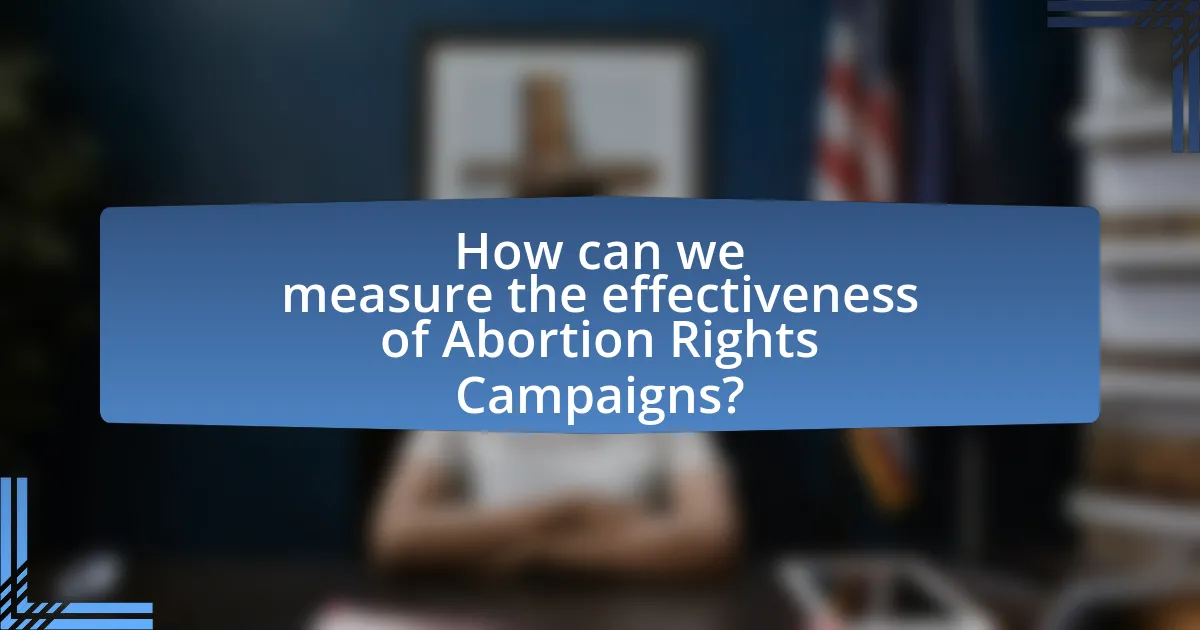
How can we measure the effectiveness of Abortion Rights Campaigns?
The effectiveness of Abortion Rights Campaigns can be measured through various metrics, including changes in public opinion, legislative outcomes, and access to abortion services. Public opinion can be assessed through surveys that track shifts in attitudes towards abortion rights over time, indicating the campaign’s influence on societal views. Legislative outcomes, such as the introduction or repeal of laws related to abortion access, serve as direct indicators of a campaign’s success in shaping policy. Additionally, measuring access to abortion services, including the number of clinics and the availability of safe procedures, provides concrete evidence of the campaign’s impact on reproductive health services. For instance, after the 2016 campaign in Ireland, public support for abortion rights increased significantly, leading to the repeal of the Eighth Amendment in 2018, demonstrating a clear correlation between campaign efforts and legislative change.
What metrics are used to evaluate campaign success?
Metrics used to evaluate campaign success include engagement rates, conversion rates, reach, and return on investment (ROI). Engagement rates measure how actively the audience interacts with campaign content, while conversion rates indicate the percentage of individuals who take a desired action, such as signing a petition or donating. Reach quantifies the total number of people exposed to the campaign, and ROI assesses the financial return relative to the campaign’s costs. These metrics provide a comprehensive view of a campaign’s effectiveness in achieving its goals.
How do we assess changes in public opinion?
Changes in public opinion are assessed through systematic surveys and polls that measure attitudes over time. These surveys often utilize representative samples to ensure accuracy, employing methods such as Likert scales to gauge levels of agreement or disagreement on specific issues, including abortion rights. For instance, the Pew Research Center regularly conducts surveys that track shifts in public sentiment regarding abortion, revealing trends and demographic differences. Analyzing the data from these surveys allows researchers to identify significant changes in public opinion, providing insights into how campaigns may influence societal views on abortion rights.
What role does legislative change play in measuring effectiveness?
Legislative change serves as a critical indicator in measuring the effectiveness of abortion rights campaigns. When laws are enacted or amended to expand or restrict abortion access, these changes provide tangible evidence of the campaign’s influence on public policy. For instance, the passage of the Reproductive Health Act in New York in 2019, which codified abortion rights into state law, reflects the successful advocacy efforts of pro-choice organizations. This legislative shift can be quantitatively assessed through metrics such as the number of abortions performed, access to reproductive health services, and public opinion trends following the change. Thus, legislative outcomes directly correlate with the effectiveness of advocacy strategies employed by abortion rights campaigns.
What challenges do Abortion Rights Campaigns face?
Abortion rights campaigns face significant challenges, including legal restrictions, societal stigma, and funding limitations. Legal restrictions arise from varying state laws that can impose waiting periods, mandatory counseling, and gestational limits, which hinder access to abortion services. Societal stigma manifests through public opposition and misinformation, which can deter individuals from seeking support or participating in advocacy efforts. Funding limitations restrict the ability of organizations to effectively mobilize resources for outreach, education, and legal battles, impacting their overall effectiveness. For instance, a 2021 report by the Guttmacher Institute highlighted that 90% of U.S. counties lack an abortion provider, illustrating the impact of restrictive laws and funding challenges on access to services.
How do opposition groups affect campaign outcomes?
Opposition groups significantly influence campaign outcomes by mobilizing resources, shaping public opinion, and creating counter-narratives. For instance, during the 2016 U.S. presidential election, opposition groups like the anti-abortion movement effectively organized campaigns that highlighted the potential consequences of abortion policies, swaying undecided voters. Research indicates that well-funded opposition groups can increase voter turnout against a campaign, as seen in various state-level abortion rights initiatives where opposition mobilization led to defeats in ballot measures. This demonstrates that the presence and actions of opposition groups can directly alter the trajectory and success of campaigns focused on abortion rights.
What legal barriers impact the effectiveness of these campaigns?
Legal barriers significantly hinder the effectiveness of abortion rights campaigns by imposing restrictions on access to reproductive health services. For instance, laws such as mandatory waiting periods, parental consent requirements, and targeted regulation of abortion providers (TRAP laws) create obstacles that can delay or prevent individuals from obtaining abortions. According to the Guttmacher Institute, as of 2023, 26 states have enacted laws that restrict access to abortion services, which directly impacts the ability of campaigns to mobilize support and provide necessary resources to those in need. These legal constraints not only limit access but also contribute to misinformation and stigma surrounding abortion, further complicating advocacy efforts.

What are the outcomes of successful Abortion Rights Campaigns?
Successful abortion rights campaigns lead to increased access to safe and legal abortion services, improved reproductive health outcomes, and enhanced gender equality. For instance, countries that have liberalized abortion laws, such as Canada and several European nations, have seen a significant decrease in maternal mortality rates associated with unsafe abortions. According to the World Health Organization, access to safe abortion services is crucial for reducing health risks and promoting women’s autonomy. Furthermore, successful campaigns often result in the establishment of supportive legal frameworks that protect women’s rights, as evidenced by the legalization of abortion in various jurisdictions following sustained advocacy efforts. These outcomes collectively contribute to a more equitable society where women’s health and rights are prioritized.
How do successful campaigns change laws and policies?
Successful campaigns change laws and policies by mobilizing public support, influencing lawmakers, and leveraging media attention. For instance, the 2016 campaign for abortion rights in Ireland, which culminated in the repeal of the Eighth Amendment, showcased how grassroots organizing and public demonstrations can shift societal attitudes and pressure political leaders to enact legislative changes. This campaign utilized social media to amplify voices and gather widespread support, ultimately leading to a national referendum that resulted in a significant policy shift.
What examples exist of significant legislative changes resulting from these campaigns?
Significant legislative changes resulting from abortion rights campaigns include the legalization of abortion in several U.S. states, such as New York’s Reproductive Health Act of 2019, which expanded access to abortion services and removed outdated restrictions. Additionally, the 1973 Supreme Court decision in Roe v. Wade established a woman’s legal right to choose abortion, fundamentally altering the legal landscape across the country. These changes were driven by extensive advocacy and public mobilization efforts from organizations like Planned Parenthood and the National Organization for Women, which highlighted the need for reproductive rights and influenced public opinion and legislative action.
How do successful campaigns improve access to abortion services?
Successful campaigns improve access to abortion services by raising public awareness, influencing policy changes, and mobilizing community support. For instance, campaigns that effectively communicate the importance of reproductive rights can lead to legislative reforms that expand access to abortion services, as seen in the 2019 Reproductive Health Act in New York, which aimed to protect and expand access to abortion. Additionally, successful campaigns often provide resources and support networks, such as funding for clinics and educational materials, which directly enhance service availability. Research indicates that states with active abortion rights campaigns experience a higher number of clinics and better access to services, demonstrating the tangible impact of these efforts on reproductive health access.
What lessons can be learned from past Abortion Rights Campaigns?
Past abortion rights campaigns demonstrate the importance of grassroots mobilization and coalition-building. Successful campaigns, such as the 1973 Roe v. Wade movement, highlighted that engaging diverse groups, including women’s rights organizations, healthcare professionals, and civil rights activists, can amplify voices and create a unified front. Additionally, the campaigns showed that effective communication strategies, including the use of personal stories and data-driven arguments, resonate with the public and policymakers, as evidenced by the widespread support for reproductive rights following the mobilization efforts in the 1990s. Furthermore, the historical context of these campaigns reveals that legal victories must be accompanied by ongoing advocacy to protect and expand rights, as seen in the backlash against Roe v. Wade in subsequent decades.
What strategies have proven most effective in previous campaigns?
Effective strategies in previous abortion rights campaigns include grassroots mobilization, targeted messaging, and coalition-building. Grassroots mobilization has been shown to increase community engagement and voter turnout, as evidenced by the 2018 midterm elections where organizations like Planned Parenthood and NARAL Pro-Choice America mobilized volunteers to educate voters on reproductive rights. Targeted messaging, particularly through social media, has proven effective in reaching younger demographics, as seen in campaigns that utilized platforms like Instagram and Twitter to share personal stories and statistics. Coalition-building among various advocacy groups has also strengthened campaigns, exemplified by the Women’s March in 2017, which united diverse organizations to amplify their collective voice for reproductive rights. These strategies have consistently demonstrated their effectiveness in advancing abortion rights initiatives.
How can future campaigns build on past successes and failures?
Future campaigns can build on past successes and failures by conducting thorough evaluations of previous initiatives to identify effective strategies and areas for improvement. For instance, analyzing the 2016 campaign for abortion rights in Ireland reveals that grassroots mobilization and clear messaging significantly contributed to its success, as evidenced by the 66.4% vote in favor of repeal. Conversely, campaigns that failed to resonate with the target audience, such as certain messaging strategies in the 2018 midterm elections in the United States, highlight the importance of tailoring approaches to specific demographics. By leveraging data from these evaluations, future campaigns can refine their tactics, enhance engagement, and increase the likelihood of achieving their objectives.
What practical steps can be taken to enhance the effectiveness of Abortion Rights Campaigns?
To enhance the effectiveness of abortion rights campaigns, organizations should focus on grassroots mobilization, strategic partnerships, and data-driven advocacy. Grassroots mobilization involves engaging local communities through education and outreach, which can increase public support and participation. Strategic partnerships with healthcare providers, legal experts, and other advocacy groups can amplify resources and messaging, creating a united front. Data-driven advocacy, supported by research from organizations like the Guttmacher Institute, demonstrates the impact of access to abortion services on public health, thereby strengthening arguments for policy changes. These steps collectively create a more robust and effective campaign framework.
